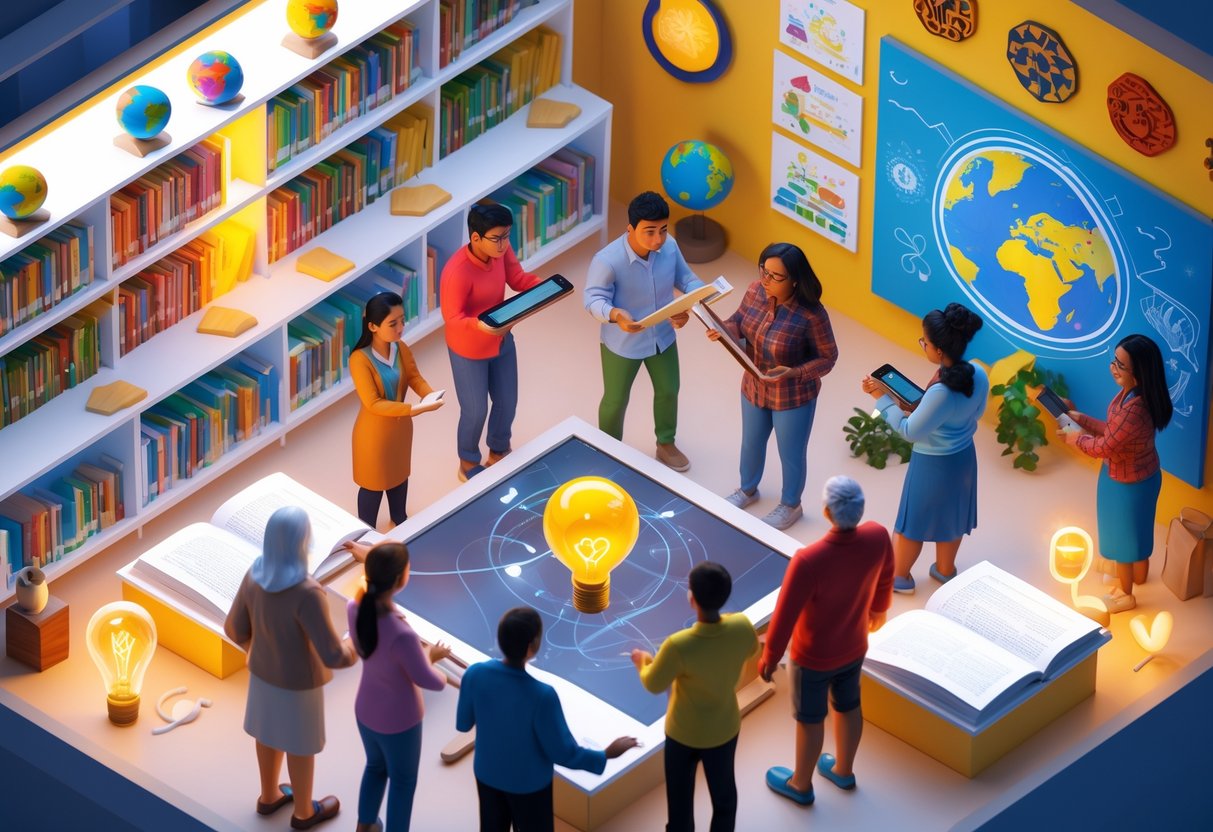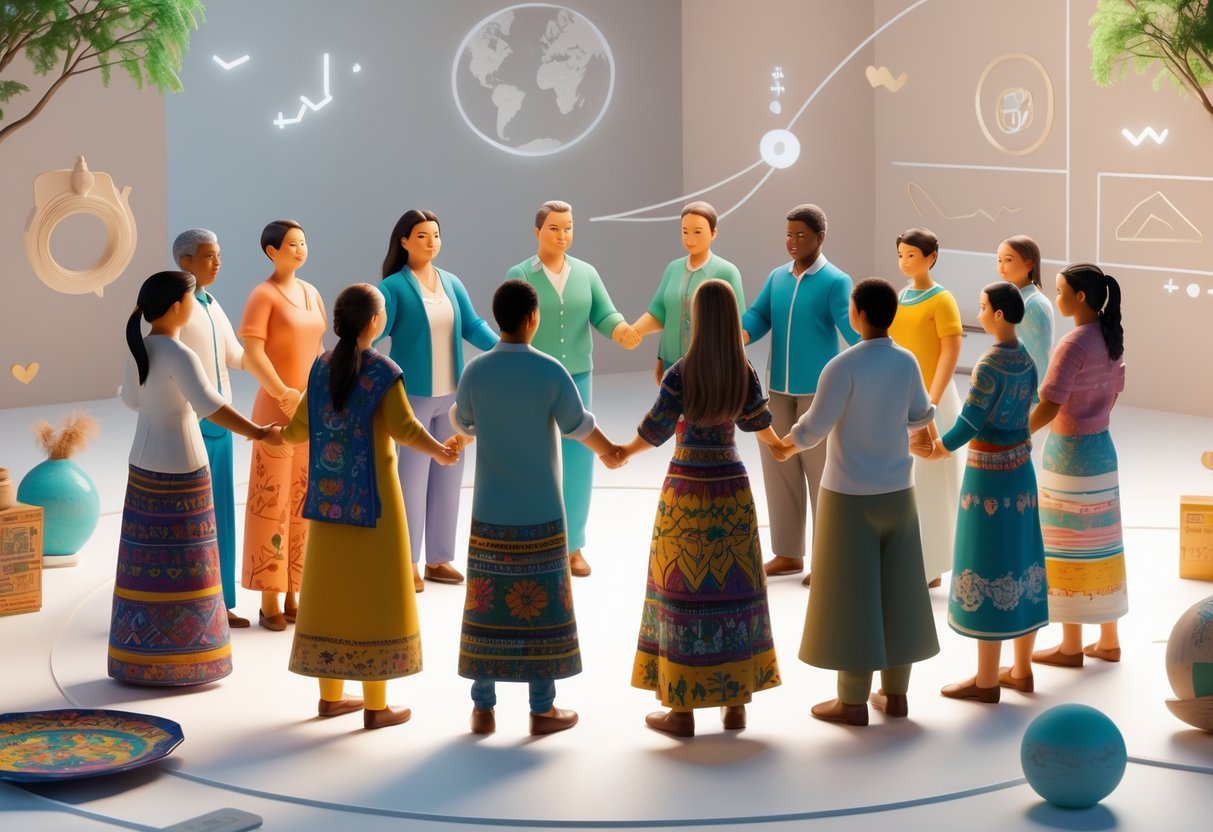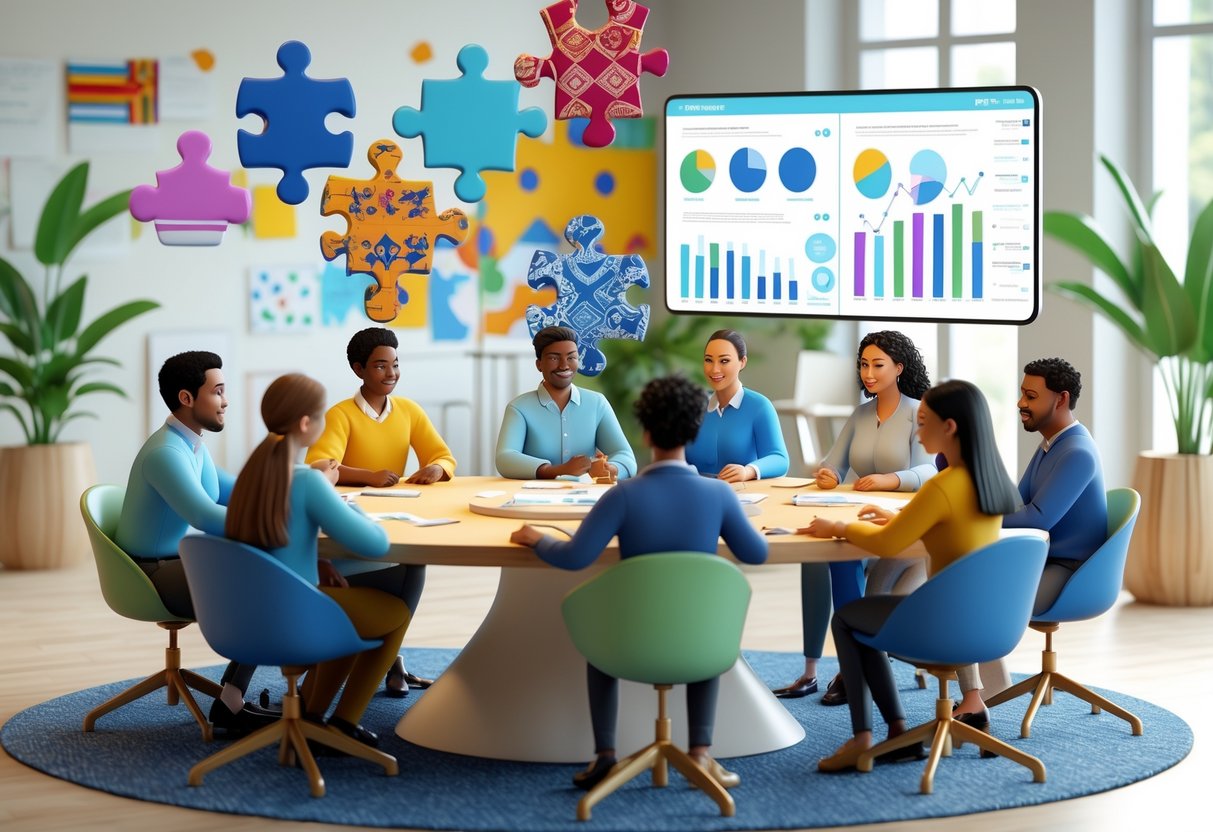Cultural Sensitivity: Key Strategies, Contexts, and Applications
Updated On: October 23, 2025 by Aaron Connolly
Defining Cultural Sensitivity
Cultural sensitivity means noticing and respecting the differences between people from all sorts of backgrounds.
We have to realize our own culture shapes how we see the world, but at the same time, other people’s values, beliefs, and habits might be totally different.
Core Principles of Cultural Sensitivity
A few core principles guide us when we try to be culturally sensitive with folks from different backgrounds.
Awareness comes first. We need to notice our own biases and assumptions before we can really understand anyone else.
This involves thinking about how our upbringing and experiences color our judgments.
Respect isn’t just about tolerating differences; it’s about actively valuing them.
We should appreciate things like different religious practices, family setups, communication habits, and social rules.
Understanding means learning about other cultures without jumping to conclusions.
It’s better to ask respectful questions and actually listen to people’s stories instead of falling back on stereotypes.
Non-judgement is all about resisting the urge to think our way is best.
Just because something’s unfamiliar doesn’t make it wrong—sometimes what seems odd to us is completely normal in another context.
Adaptability shows up when we tweak our behavior to fit the situation.
Maybe that means changing how we communicate, showing respect in new ways, or being flexible about customs.
The Evolution of Cultural Sensitivity
Cultural sensitivity has changed a lot over time.
It started out as just basic tolerance—people were told to get along, but there wasn’t much thought about deeper cultural differences.
Things shifted as civil rights movements showed how cultural insensitivity could really hurt people and communities.
Studies in psychology and sociology uncovered how cultural differences shape communication, learning, and even healthcare.
With globalisation, people from all over started working and living together more often.
Suddenly, cultural misunderstandings had bigger consequences.
Now, we see cultural sensitivity as an active skill.
It takes ongoing learning and a bit of honest self-reflection.
The focus has moved from just avoiding offense to actually creating spaces where everyone can thrive.
Technology and social media have changed the game, too.
People connect across cultures instantly online, so cultural awareness matters even more.
Cultural Sensitivity and Diversity
Cultural sensitivity is what makes diversity a real asset instead of a challenge.
Diversity means people bring different perspectives and ways of solving problems.
But without cultural sensitivity, those differences can turn into misunderstandings or even conflict.
Cultural sensitivity helps us see the multiple identities every person carries.
Someone’s shaped by their ethnicity, religion, background, age, gender, and more—all at once.
We try not to put people into just one box.
Effective communication means understanding that styles and expectations vary.
Some cultures like things direct, others go for a softer touch.
Some focus on individual achievements, while others care more about group harmony.
It’s also important to notice power dynamics.
Some groups have faced discrimination or marginalization, and being aware of that can help us avoid repeating harmful patterns.
Bringing together cultural sensitivity and diversity leads to more creativity, better problem-solving, happier customers, and stronger communities.
When people feel understood, they’re more likely to pitch in and help everyone succeed.
Importance of Respect in Cross-Cultural Settings
Respect is the backbone of good cross-cultural relationships.
When we genuinely respect cultural differences, we set the stage for trust and real connections to grow.
Demonstrating Respect for Cultural Differences
Showing respect starts with accepting that our way isn’t the only way.
We need to listen without judging when someone shares their culture.
Asking thoughtful questions about traditions we’re not familiar with—like a colleague’s holiday—shows we care, instead of brushing it off as odd.
Active listening matters a lot.
That means giving people our full attention, asking for clarification, not interrupting, and repeating back what we’ve heard to make sure we got it right.
The words we use matter too.
Inclusive language avoids putting one culture above another.
Instead of calling something “weird,” we might say, “That’s different from what I know.”
It’s also okay to admit we don’t know everything.
We don’t have to be experts, but we should stay open to learning.
Cultural Norms and Social Expectations
Every culture has unspoken rules for how to act in social and work settings.
These norms cover everything from greetings to how decisions get made.
Understanding these helps us avoid awkward moments.
For example, direct eye contact might show respect in some places but come across as rude elsewhere.
Communication styles can look really different, too:
| Direct Cultures | Indirect Cultures |
|---|---|
| Clear, explicit messages | Subtle, contextual communication |
| Frank feedback | Gentle suggestions |
| Quick decisions | Consensus-building |
Personal space is another thing that shifts.
What feels friendly in one culture might seem pushy in another.
We need to pay attention and adjust as we go.
Time works differently, too.
Some cultures put a premium on punctuality; others care more about building relationships than sticking to a schedule.
It’s not about right or wrong—just different values.
Social hierarchies can affect how people interact at work and in their communities.
If we notice these patterns, we can communicate more effectively.
Building Trust Across Cultures
Trust takes time, especially when cultures differ.
We build it through small, consistent actions, not big gestures.
Reliability is universal.
When we keep our promises and show up when we say we will, we prove we value the relationship.
Cultural humility helps trust grow faster.
Admitting when we don’t know something and being willing to learn from others goes a long way.
To strengthen trust, we can admit our mistakes, show real interest in others’ views, share a bit about ourselves, and keep things confidential.
Patience is key.
Relationships that move fast in our own culture might take longer when there are cultural differences.
We need our words and actions to match.
People might interpret things differently, so we should watch out for mixed messages.
When conflicts pop up—and they always do—handling them with respect can actually make trust stronger.
Focusing on understanding each other, rather than who’s right, keeps things moving forward.
Communication Across Cultures
Communication styles can look wildly different from one culture to another.
We have to adapt how we talk and listen, depending on who we’re with.
It’s all about figuring out how people express themselves and finding ways to get past the usual barriers.
Adapting Communication Styles
Cultures shape how people communicate.
Some go straight to the point, while others prefer a gentler touch.
Countries like Germany and the US lean toward direct talk—people say what they mean.
The phrase “Say what you mean and mean what you say” sums it up.
Places like Japan or many Arab nations favor indirect communication.
The Japanese saying “Hear one, understand ten” hints at the expectation to read between the lines.
People often rely on hints instead of spelling things out.
Emotional expression shifts, too.
Some cultures are open with their feelings, while others keep things more buttoned up.
The Irish might say, “What is nearest the heart is nearest the mouth,” but in China, “The first one to raise their voice loses the argument.”
We need to adjust our approach.
With indirect cultures, it’s smart to listen for subtle signals.
With direct ones, being clear works best.
Understanding Cultural Nuances in Language
Language is full of hidden meanings that go beyond just words.
These cultural nuances shape how people hear what we’re saying.
Non-verbal communication makes up most of our face-to-face interaction.
Eye contact rules, for example, are all over the map.
In some Western countries, direct eye contact signals confidence.
Elsewhere, it might seem rude.
Personal space is another thing.
Some cultures like to stand close, while others need more distance.
Context also matters.
High-context cultures rely on background and relationships.
Low-context cultures stick to what’s actually said or written.
We should try to learn these unspoken rules before big meetings or conversations.
What seems polite to us might come off badly somewhere else.
Companies that train employees in these differences tend to build stronger international ties.
Overcoming Communication Barriers
Lots of things can get in the way of clear cross-cultural communication.
But we can tackle them, one by one.
Virtual communication adds extra hurdles.
Without body language, online meetings lose a lot of nuance.
That drops our effectiveness way down.
To make virtual chats work better, we can use video, speak slowly, double-check understanding, and give people more time to respond.
Language differences trip us up, too.
Even when we share a language, technical jargon or slang can cause confusion.
Assumptions might be the biggest barrier.
We often think our way of doing things works everywhere, but it rarely does.
Cultures differ on decision-making, deadlines, and handling conflict.
The key is to accept these differences and prepare for cross-cultural interactions, instead of just hoping things will go smoothly.
Overcoming Implicit Bias and Barriers
We all have unconscious biases that make cultural sensitivity harder.
Learning to spot these biases and practicing self-reflection helps us connect better with people from different backgrounds.
Recognising Implicit Biases
Implicit biases are automatic thoughts and feelings we have about people, often based on how they look or where they’re from.
Most of us don’t even notice we’re doing it.
These biases can show up in how we treat others, even if we don’t mean to act that way.
We might make snap judgments about someone’s abilities, feel uneasy around people who seem different, or assume things about someone’s culture without checking.
Self-reflection helps us catch these patterns.
We can ask ourselves why we react a certain way to different people.
Jotting down our thoughts after talking with others can reveal habits we didn’t realize we had.
When we notice ourselves making assumptions, we can hit pause and question them.
Mitigating Stereotypes and Prejudices
Stereotypes are oversimplified ideas about whole groups of people.
They ignore how unique each person really is.
Learning about different cultures helps break down these stereotypes.
We can get to know people as individuals, read books or watch films from other cultures, attend community events, or just ask questions instead of making guesses.
Active listening is crucial.
When someone shares their story, we should focus on what they’re saying, not on what we think we know about their background.
Challenging stereotypes takes practice.
Every time we catch ourselves making assumptions, we have a chance to learn something new.
Strategies for Self-Reflection
Self-reflection means taking an honest look at our thoughts and actions. When we do this, we grow and get better at understanding people from different cultures.
Try asking yourself questions every day:
- What assumptions did I make today?
- How did my background shape how I reacted?
- What can I learn from my interactions with others?
Keeping a reflection journal lets you track your progress. Jotting down your experiences can reveal patterns in your thinking.
Regular mindfulness practice helps boost your awareness. When you notice your thoughts without judging them, you can spot biases as they come up.
Ask for feedback from friends or colleagues you trust. Sometimes, they catch things you might miss about your own biases.
Set aside a bit of time each week just for reflection. Even ten minutes can make a difference in how you notice your reactions to others.
Creating an Inclusive Environment

If we want truly inclusive workplaces, we have to use strategies that value different backgrounds and perspectives. Good diversity, equity, and inclusion (DEI) programs help cultural sensitivity become part of the everyday environment.
Fostering Inclusive Environments
Building an inclusive environment starts when we recognize that people from diverse backgrounds bring unique perspectives. These perspectives can make teams stronger.
We can’t stop at just being aware. We need to take action with real inclusion strategies.
Open communication is the backbone of inclusive workplaces. Let’s set up feedback channels so employees can safely share concerns about cultural insensitivity.
Regular team meetings that welcome different viewpoints help build trust.
Inclusive policies show our commitment in action. Some examples:
• Diverse hiring practices that actively reach out to underrepresented communities
• Zero-tolerance policies for discrimination based on cultural identity
• Flexible benefits that fit religious observances and cultural needs
• Fair promotion processes that recognize different leadership styles
We should celebrate diversity with cultural events, awareness days, and recognition programs. These activities help everyone learn about different traditions and feel valued.
Leadership accountability matters a lot. When managers model inclusive behavior and talk about their own learning, it makes the workplace safer for everyone.
Role of DEI in Cultural Sensitivity
DEI programs give us a framework to turn good intentions about cultural sensitivity into real results. These efforts make inclusion systematic instead of random.
Training and education are at the heart of DEI. We run workshops on unconscious bias, offer cultural competency sessions, and set up ongoing learning modules.
This helps employees see how their backgrounds shape their perspectives.
Measurement and tracking keep us honest. We use regular surveys to check how employees from different backgrounds are experiencing the workplace.
We also watch recruitment, retention, and promotion rates to spot any barriers.
Employee resource groups (ERGs) offer colleagues from similar backgrounds a place to connect and push for change. These groups often catch blind spots that leadership might overlook.
Mentorship programs pair employees from different cultures, building understanding and supporting career growth. These relationships can break down cultural barriers naturally.
DEI frameworks help us tackle systemic issues that might hold certain groups back. We review job descriptions for bias, make sure interview panels are diverse, and create advancement paths that respect different communication styles.
Cultural Sensitivity in Healthcare

Cultural sensitivity shapes how we deliver effective care for diverse patients. Evidence-based transcultural practices put patients’ cultural values at the center of treatment, which helps reduce health disparities.
Principles of Transcultural Nursing
Transcultural nursing lays the groundwork for culturally sensitive care. Every patient brings unique beliefs, values, and practices that affect their health choices.
Cultural humility is key. We recognize patients as the experts on their own cultural experiences. We try not to make assumptions based on stereotypes or limited information.
Some guiding principles:
- Self-reflection – look at your own biases and assumptions
- Active listening – let patients share their perspectives
- Lifelong learning – keep growing your cultural understanding
- Partnership building – work with patients and families
When we practice cultural assessment, we ask open-ended questions about what matters to patients. Even simple questions like “What’s most important to you about your care?” can start meaningful conversations.
Effective communication means adapting to each patient. We use plain language, bring in interpreters when needed, and respect different non-verbal cues.
Nursing and Patient-Centred Care
Patient-centred care brings cultural sensitivity into our daily work. We adjust our approach to fit each patient’s background and needs.
This model puts the patient’s perspective first. We ask about their health beliefs, how they want family involved, and any cultural practices that might affect care.
Building trust takes consistent, respectful interactions. If we show a real interest in patients’ backgrounds, they’re more likely to share important details.
We try to accommodate cultural practices when we can. That could mean flexible visiting hours for big families, dietary changes, or blending traditional healing with medical care.
Shared decision-making includes patients and families in choices. We lay out options clearly and respect cultural factors like family hierarchy or religious beliefs.
Training helps us build these skills. Ongoing cultural competency education keeps us up-to-date and aware of our own biases.
Addressing Health Disparities
Cultural sensitivity can improve health outcomes by closing gaps between different groups. We work to remove barriers that get in the way of fair care.
Language barriers are a big hurdle. We use professional interpreters instead of family members for medical talks. This keeps communication clear and private.
Social factors like income, education, and community resources connect with culture. We consider these when building care plans patients can actually follow.
Implicit bias training helps us spot our own hidden assumptions. Studies show these biases can affect pain management, treatment choices, and follow-up care.
We push for changes that support cultural sensitivity. That includes hiring a diverse staff, using educational materials that fit different cultures, and making policies that work for everyone.
Community partnerships take us beyond the hospital. By working with cultural organizations and local leaders, we learn more about community health beliefs and make care more accessible.
Practical Strategies for Everyday Situations

Building meaningful connections across cultures takes real action. These steps help teams trust each other and genuinely appreciate different backgrounds.
Building Trust in Diverse Teams
Trust grows when we really listen and respect different viewpoints. Start by asking teammates about how they like to communicate and work.
Some folks want direct feedback. Others need a little time to think before sharing. Figure out these differences early so you can avoid misunderstandings.
Create safe spaces for open conversation. Weekly check-ins work for small teams, while bigger groups might like anonymous feedback.
When conflicts pop up, tackle them quickly. Cultural differences can cause friction, especially with deadlines or meeting styles.
Use inclusive language in everything. Skip idioms or references that could confuse people from different backgrounds. Say “deadline” instead of “crunch time.”
Write down project goals and roles so everyone’s on the same page. This helps prevent mix-ups later.
Recognising and Valuing Cultural Events
Acknowledge key holidays and celebrations from all cultures. Set up a shared calendar with religious and cultural dates.
Don’t expect people to work during their important holidays. Try to plan projects around major events when you can.
Learn why different celebrations matter. It shows you care, not just ticking a box.
Invite team members to share their traditions—if they want to. Some love explaining their culture, some prefer to keep it private.
Offer flexible time off for religious practices. Some faiths have set prayer times or fasting.
Celebrate achievements in ways that fit everyone’s culture. Not everyone drinks or eats the same foods, so ask before planning team events.
Team Dynamics and Collaboration

Cultural sensitivity changes the way diverse teams work together. It leads to better communication and fewer misunderstandings.
When team members get how different cultures approach decisions and conflict resolution, they build trust quickly and get better results.
Enhancing Team Performance through Sensitivity
Teams with strong cultural sensitivity often outperform others by 36% in profitability. That’s a big number, but it makes sense—when people feel valued, they do their best work.
Cultures handle teamwork in different ways. Some like individual accountability, while others go for group consensus. Leaders who understand these preferences can assign tasks more effectively.
Communication styles also vary. Direct feedback works for some, but can feel too harsh for others. The best teams adapt their style to fit each person.
Trust grows when team members feel their values are respected. Simple things like recognizing religious holidays or understanding different time management styles show you care.
Quick tip: Create a team charter that lists each person’s preferred communication style and cultural needs. It can stop misunderstandings before they start.
Hold regular cultural exchange sessions so team members can learn about each other’s backgrounds. These chats often spark creative solutions.
Navigating Conflicts in Multicultural Teams
Cultural differences sometimes lead to conflict, but sensitivity helps resolve issues quickly. Most conflicts come from misunderstanding, not true disagreement.
Some cultures see direct confrontation as disrespectful and prefer private talks. Others want things out in the open. Spotting these styles early prevents problems.
Heads up: Assuming everyone handles conflict like you do usually makes things worse.
To resolve conflicts in diverse teams, try different strategies:
• Private mediation for cultures that avoid public confrontation
• Group discussions for those who value solving problems together
• Written communication for people who need time to process
• Third-party facilitators when cultural gaps feel too wide
Team dynamics get stronger when teams use conflict as a learning tool. Openly talking about cultural differences helps everyone grow.
Safe spaces for honest dialogue mean team members can share concerns without fear. Regular check-ins catch small issues before they turn into big ones.
Cultural Education and Lifelong Learning

Cultural education isn’t just about classrooms—it’s also about structured learning and daily life. Lifelong learning keeps our cultural understanding fresh and helps us keep up as the world changes.
Formal and Informal Education Methods
Traditional classrooms give us a structured way to learn about culture. Universities and schools might offer cultural studies programs that cover history, languages, and social customs.
These classes build a solid foundation.
But informal learning works too. Traveling, cultural exchanges, and community events teach us about culture in real life.
Workplace interactions and neighborhood diversity also help us grow.
Digital platforms make cultural education easier to access. Online courses, documentaries, and virtual museum tours break down barriers.
Social media connects us with people from all over, every day.
Language learning apps mix cultural info with vocabulary. They teach you the context behind words, not just grammar.
Community centers often run cultural workshops and festivals. These events let people learn hands-on, through food, music, or crafts.
Local libraries also organize multicultural programs that bring people together.
Lifelong Learning in Cultural Contexts
Cultural understanding takes ongoing effort. Societies shift, and new groups join our communities. What we learned years ago might not work today.
Self-reflection helps us grow culturally. We need to check our own biases and assumptions now and then. This honest look lets us spot gaps in our knowledge.
Professional development now includes cultural competency training. Healthcare workers, teachers, and business pros update their skills through workshops.
These sessions cover current trends and new ways to communicate.
Reading international news and media broadens our view. Following different sources helps us see global events from more than one angle. This builds empathy and sharpens our thinking.
Mentorship programs pair people from different backgrounds. These relationships let both sides learn and build friendships. Everyone gains new insights and perspectives.
Cultural organizations offer memberships with regular events and learning chances. Museums, cultural centers, and religious groups welcome folks who want to understand more.
Ethical Considerations and Responsibilities

Working across cultures brings up tough questions about what’s right or wrong. We need to think carefully about our responsibilities when we’re helping people from backgrounds different from our own.
Ethical Dilemmas in Cross-Cultural Contexts
Cultural differences can throw us into situations where our values just don’t line up with someone else’s beliefs. Sometimes, we fumble because we aren’t sure what’s respectful in a new setting.
Common ethical challenges include:
- Balancing respect for local customs with professional standards
- Deciding if a cultural practice could harm someone
- Figuring out whether to help right away or pause to understand the context
We often run into the toughest problems when we assume our way is always the best. Direct communication, for example, feels normal to some, but it can come off as rude elsewhere.
Warning: If we make snap judgments about other cultures, we usually mess up and damage relationships.
It’s a balancing act, honestly. We’ve got to respect different viewpoints while sticking to basic ethical rules around safety and fairness.
Sometimes, we need to speak up against harmful practices. Other times, it makes more sense to step back and learn before acting.
Professional Responsibility in Diverse Settings
When we work with people from other cultures, we take on specific duties. These responsibilities help us avoid causing harm out of ignorance.
Our main responsibilities include:
- Learning about the cultures we work with
- Getting proper training before cross-cultural work
- Working with local partners who really know their communities
- Admitting when we’re out of our depth
We should prepare before jumping into cross-cultural situations. That means studying local customs, beliefs, and how people communicate.
Quick win: Team up with local experts. They’ll steer you away from cultural pitfalls and help you make better choices.
We also need to look out for our team members. Everyone should get cultural sensitivity training and clear guidance on respectful behavior.
When things go sideways, we need to own the problem instead of blaming cultural differences. That means having plans ready for handling conflicts or unexpected issues.
Measuring and Improving Cultural Sensitivity

If we want to measure cultural sensitivity, we need tools that track awareness, understanding, and respectful behavior across cultures. Training programs and regular feedback help us keep improving.
Assessment Tools and Metrics
We can check cultural sensitivity using a few solid methods. Feedback from people of different backgrounds gives us a clear picture of how well we’re doing.
Behavioral observation works best in everyday situations. We watch how people interact across cultures and look for signs of respect and understanding.
Survey tools let us see progress over time. They ask about cultural awareness and how comfortable people feel with diversity.
Key metrics include:
- Response rates from different cultural groups
- Satisfaction scores across diverse populations
- Incident reports of cultural misunderstandings
- Participation levels in DEI programs
We should also test knowledge of cultural norms. Simple quizzes can check if people know the basics about customs and appropriate behavior.
Warning: Don’t just rely on self-assessment surveys. People tend to rate themselves higher than reality.
Continuous Improvement Initiatives
Training programs really drive cultural sensitivity forward. They should cover cultural norms, unconscious bias, and practical communication skills.
Workshops let people practice real-life intercultural situations. Role-playing gives everyone a safe way to see things from another point of view.
Mentorship programs pair people from different backgrounds. This helps everyone learn naturally and builds understanding over time.
We need feedback that goes both ways. Regular check-ins with diverse team members show us blind spots and where we can do better.
Quick win: Try monthly cultural awareness sessions where different groups share their traditions and workplace needs.
DEI efforts work best when they’re part of daily routines. Instead of separate training, we should weave cultural sensitivity into meetings and regular processes.
Track progress through quarterly reviews. Look for more comfort, fewer complaints, and better participation from all cultural groups.
Frequently Asked Questions

Cultural sensitivity brings up lots of practical questions about how to show respect and understanding in different settings. People usually want to know about workplace practices, communication, healthcare, and how organizations can build more inclusive spaces.
What are some practical ways to showcase cultural sensitivity in the workplace?
We can start by recognizing and celebrating important cultural events like Diwali, Eid, or Lunar New Year. It’s a simple way to show respect for different backgrounds and help everyone feel included.
Flexible leave policies let employees observe their own cultural occasions. We should also encourage team members to share their traditions if they want.
Learning basic greetings or customs from other cultures shows we care. Even small things, like considering dietary restrictions at work events, can mean a lot.
We shouldn’t assume things about someone’s background just based on appearance or names. Instead, let’s ask respectful questions when cultural context matters for a project.
How does cultural sensitivity enhance communication in multicultural environments?
Cultural sensitivity helps us avoid misunderstandings that come from different communication styles. Some cultures like things direct, others prefer a softer approach.
We start to notice non-verbal cues that change from place to place. Eye contact, personal space, and gestures can mean totally different things depending on where you are.
Understanding context keeps us from misreading silence, tone, or how quickly someone responds. What feels rude to us might be normal for someone else.
Active listening works better when we think about cultural perspectives. We can tweak our communication style to fit what each person prefers.
Why is cultural sensitivity particularly important in healthcare settings?
Healthcare decisions often tie into deep cultural and religious beliefs. We need to respect those values if we want patients to trust us and follow care plans.
Different cultures see pain, family roles, and medical authority in unique ways. When healthcare providers get this, they give better care.
Cultural sensitivity cuts down on medical errors that happen when patients don’t feel safe sharing information. Trust grows when patients know we get where they’re coming from.
Sometimes treatments clash with cultural or religious practices. We should work with patients to find solutions that fit their beliefs and still meet medical standards.
Could you explain the difference between cultural sensitivity and cultural awareness?
Cultural awareness means we realize differences exist between groups. It’s the first step in understanding diversity.
Cultural sensitivity goes further. We show respect and adjust our behavior to avoid stereotypes and prejudice.
Awareness is about knowing; sensitivity is about doing. We might know about differences but still act insensitively if we don’t apply what we’ve learned.
Cultural sensitivity takes ongoing effort. It’s not enough to just notice differences—we have to respond the right way.
In what ways can professionals in nursing demonstrate cultural sensitivity towards their patients?
Nurses can learn about the cultural backgrounds of the patients they serve. That means understanding health beliefs, family roles, and how people prefer to communicate.
We should ask patients about their cultural needs instead of guessing. Questions about diet, religion, or family involvement show we care about what matters to them.
Providing interpreters when needed keeps communication clear. But we also need to remember that family members aren’t always the best interpreters for sensitive topics.
Respecting modesty and religious practices during care builds trust. Even small things—like time for prayer or honoring dietary rules—can make patients feel much more comfortable.
What steps can organisations take to educate their employees on the importance of cultural sensitivity?
Regular training sessions really help employees pick up on cultural differences and see how these differences shape work relationships. It’s best if these trainings use practical examples that actually fit the organisation’s day-to-day reality.
You can also set up mentorship programmes where employees from different backgrounds pair up. Honestly, people often learn more from personal connections than from any formal training.
Employee resource groups give folks a safe spot to swap stories and learn about each other’s cultures. These groups might organise cultural awareness events or offer feedback on company policies—sometimes their ideas are surprisingly insightful.
Leadership needs to actually show what culturally sensitive behaviour looks like. They should make it obvious that respecting diversity isn’t just a slogan but a real core value.
If someone acts in a culturally insensitive way, there should be clear consequences. Otherwise, it just sends the wrong message.

